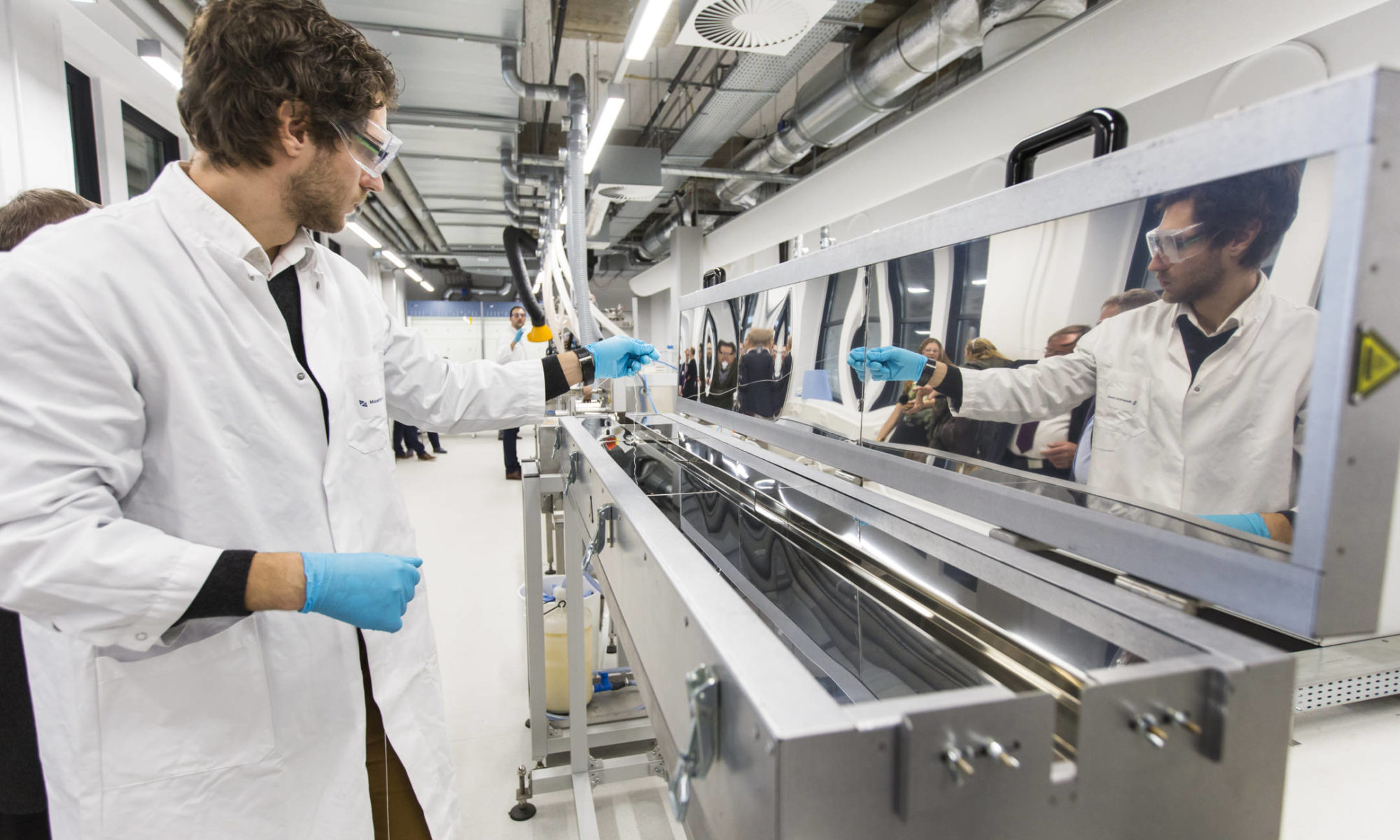AMIBM (Aachen-Maastricht Institute for Biobased Materials), the cross-border cooperation between Maastricht University, RWTH Aachen University and Frauenhofer IME, focuses on the transition from fossil materials to the manufacture of polymers and products from natural raw materials.
Research at AMIBM is organised along five lines of research, which run almost parallel with the value chain from biobased raw material to application. Naturally, sustainability plays a major role in the entire chain. Although the institute is still very young, it is experiencing strong growth. ‘We started two years ago and now employ 58 people. I believe the secret is the enthusiasm and the way we are able to integrate and communicate the research and the developments. Thanks to very close cooperation along the entire value chain, truly valuable new or optimised polymers and applications are being created.’
Inspired by nature
Jockenhövel is extremely pleased with the Wet Spinning Line (see box) which has obtained a place in the new facility at the Brightlands Chemelot Campus. The polymers to be spun with the Wet Spinning Line are intended in particular for biomedical applications. This entails close cooperation with the biomedical industry and doctors, from organisations such as the University Hospital in Aachen, the Maastricht University Medical Centre and the Heart Centre in Bad Oeynhausen, the world’s largest heart centre. Examples include heart valves, stents, materials for wound healing and regenerative medicine.
Although Jockenhövel has a medical background, he has always been interested in materials research. ‘Many innovations in biomaterials research stem from important medical innovations. Classic examples are soluble sutures and the discovery of titanium for artificial knees and hip prostheses.’
Jockenhövel’s inspiration for innovative biomaterials comes from nature. ‘Did you know that our bodies, just like textiles, are composed of polymer fibres? Collagen which makes our skin firm, or elastin which makes the skin supple: just a few examples of natural polymer fibres whose biomechanical properties we can copy. I try to imitate that.’
Spinning at room temperature
The system at the Chemelot Campus complements the equipment which was already present in the facilities in Maastricht and Aachen. Two different polymers can be processed here into a single fibre, a bi-component fibre. Depending on the spinning head used, the structure of the bi-component fibre can be specified very precisely so it has the required properties.
However, bi-component fibres can also be manufactured with the Melt Spinning technique, for example. What makes this system unique, as opposed to a Melt Spinning system, is that the spinning process takes place entirely at room temperature. This makes it possible to make polymer fibres from temperature-sensitive (bio) polymers to which, for example, medicines, peptides or growth factors can be added. ‘Proteins will denature above a certain temperature and, just like a boiled egg, lose their biological function. Spinning at room temperature is essential for the (bio) functional applications we want to make with these polymer fibres,’ explains Jockenhövel.
Biomedical products in the short term
For AMIBM, research into polymer fibres is its daily business. But the Wet Spinning Line is more than just a tool for making polymer fibres. It is also a (research) project in itself. ‘In order to get the best out of it, we will need at least a year to get to know and improve the machine and the technology. It is not something you can learn from a textbook. Fortunately we are in excellent contact with the supplier of the system. That allows us to make any adjustments which might be required.’
Jockenhövel expects that the first biomedical products made from AMIBM’s polymer fibres will be ready for clinical testing within two years. What still needs to be done?
‘Currently we have no ceiling above the system. The reason is simple. We want to build a clean room around the Wet Spinning Line in the future. A clean room is a room in which polymer fibres can be manufactured under strictly regulated conditions. Only then will they be suitable for use in biomedical applications.’
Biobased fibre for the textile industry
‘Third parties are very welcome to use the Wet Spinning Line for polymer research or production,’ according to Jockenhövel. ‘Indeed, we seek cooperation with third parties. In principle the Wet Spinning Line can also be used for non-biomedical applications, as long as this does not interfere with the strict requirements for the biomedical applications. Thus strong biobased polymer fibres with anti-allergenic properties can for instance be put to good use in the carpet or textile industry. But you always have to keep in mind whether wet spinning is the most efficient way for producing the required polymer fibres. Depending on the properties of the fibres, existing technology applicable on an industrial scale may prove more feasible.’



